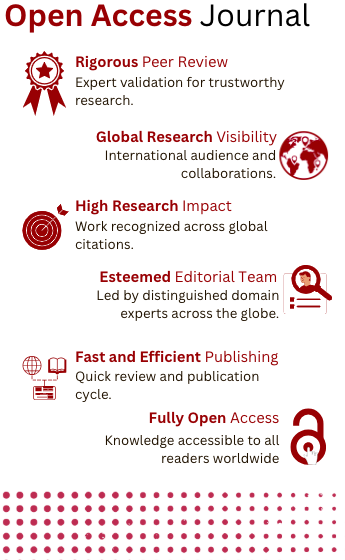Animal Intrusion Detection using Deep Learning and Transfer Learning Approaches
Keywords:
Animal Intrusion Detection, Deep Learning, Transfer Learning, Image processing, CNN, VGG-16, VGG-19, MobileNetAbstract
One of the major risks to decreasing the harvest yield is crop damage caused by monster attacks. Crop attacking is one of the most aggravating conflicts between tamed and untamed life as a result of the expansion of developed land into former natural life habitat. India's ranchers are in grave risk from pests, natural calamities, and animal attacks that reduce production. Employing gatekeepers to keep an eye on crops and deter wild animals is not a practicable solution, contrary to conventional wisdom used by ranchers. Since the safety of both humans and animals is crucial, it is essential to protect the crops from animal-caused damage and to reroute the animal with little chance of mischief. In order to overcome these problems and get to our point, we employ artificial intelligence (AI) to detect animals as they enter our ranch using a division of computer vision known as a deep brain network. This paper promotes the ability to identify organisms in the natural world. Since there are so many different types of species, it might be difficult to physically discern between them. This algorithm organises animals based on their images so that we may more effectively filter them. In this paper, we will use a camera to take daily pictures of the surrounding area while simultaneously seeing the entire ranch at regular intervals. With the aid of sophisticated learning models, we can recognise the movement of creatures and play the appropriate sounds to scare them away. The various convolutional brain network libraries and concepts used to create the model are identified in this Paper.
References
Santhiya, S., Dhamodharan, Y., Priya, N. E. K., Santhosh, C. S., & Surekha, M. (2018). A smart farmland using Raspberry Pi crop prevention and animal intrusion detection system. Int. Res. J. Eng. Technol, 5(3), 3829-3832.
Andavarapu, N., & Vatsavayi, V. K. (2017). Wild-animal recognition in agriculture farms using W-COHOG for agro-security. International Journal of Computational Intelligence Research, 13(9), 2247-2257.
Duhart, C., Dublon, G., Mayton, B., & Paradiso, J. (2019). Deep learning locally trained wildlife sensing in real acoustic wetland environment. In International Symposium on Signal Processing and Intelligent Recognition Systems (pp. 3-14). Springer, Singapore.
Jordan, M., & Jacobs, R. (1991). Hierarchies of adaptive experts. Advances in neural information processing systems, 4.
He, K., Zhang, X., Ren, S., & Sun, J. Deep residual learning for image recognition (2015). cite. arXiv preprint arxiv:1512.03385.
Hermans, A., Beyer, L., & Leibe, B. (2017). In defense of the triplet loss for person re-identification. arXiv preprint arXiv:1703.07737.
Ahmed, S. T. (2017, June). A study on multi objective optimal clustering techniques for medical datasets. In 2017 international conference on intelligent computing and control systems (ICICCS) (pp. 174-177). IEEE.
Sailesh, K., Balina, H. V., Sivakumar, T., & Vijaya Poojitha, P. (2019). Detection of wild elephants using image processing on raspberry pi3. 2019 International journal of Computer Science and Mobile Computing. ijcsmc, 8(2).
Karanth, K. K., & Kudalkar, S. (2017). History, location, and species matter: insights for human–wildlife conflict mitigation from India. Human dimensions of wildlife, 22(4), 331-346.
Gunashree, M., Ahmed, S. T., Sindhuja, M., Bhumika, P., Anusha, B., & Ishwarya, B. (2020). A New Approach of Multilevel Unsupervised Clustering for Detecting Replication Level in Large Image Set. Procedia Computer Science, 171, 1624-1633.
Sreedhar, S., Ahmed, S., Flora, P., Hemanth, L. S., Aishwarya, J., & Naik, R. (2021, January). An Improved Approach of Unstructured Text Document Classification Using Predetermined Text Model and Probability Technique. In Proceedings of the First International Conference on Advanced Scientific Innovation in Science, Engineering and Technology, ICASISET 2020, 16-17 May 2020, Chennai, India.
Kuznetsova, A., Rom, H., Alldrin, N., Uijlings, J., Krasin, I., Pont-Tuset, J., ... & Ferrari, V. (2020). The open images dataset v4. International Journal of Computer Vision, 128(7), 1956-1981.
Korschens, M., & Denzler, J. (2019). Elpephants: A fine-grained dataset for elephant re-identification. In Proceedings of the IEEE/CVF International Conference on Computer Vision Workshops (pp. 0-0).
Li, S., Li, J., Tang, H., Qian, R., & Lin, W. (2019). ATRW: a benchmark for Amur tiger re-identification in the wild. arXiv preprint arXiv:1906.05586.
Lin, T. Y., Maire, M., Belongie, S., Hays, J., Perona, P., Ramanan, D., ... & Zitnick, C. L. (2014, September). Microsoft coco: Common objects in context. In European conference on computer vision (pp. 740-755). Springer, Cham.
Liu, C., Zhang, R., & Guo, L. (2019). Part-pose guided amur tiger re-identification. In Proceedings of the IEEE/CVF International Conference on Computer Vision Workshops.
Liu, W., Anguelov, D., Erhan, D., Szegedy, C., Reed, S., Fu, C. Y., & Berg, A. C. (2016, October). Ssd: Single shot multibox detector. In European conference on computer vision (pp. 21-37). Springer, Cham.
Luo, H., Gu, Y., Liao, X., Lai, S., & Jiang, W. (2019). Bag of tricks and a strong baseline for deep person re-identification. In Proceedings of the IEEE/CVF conference on computer vision and pattern recognition workshops (pp. 0-0).
Rangarajan, K. (2021, March). Digital Borders: Design of an Animal Intrusion Detection System Based on Deep Learning. In Computer Vision and Image Processing: 5th International Conference, CVIP 2020, Prayagraj, India, December 4-6, 2020, Revised Selected Papers, Part III (Vol. 1378, p. 186). Springer Nature.
Divya, S., Kiran, U., & Praveen, M. (2018). Iot-based wild animal intrusion detection system. International Journal on Recent and Innovation Trends in Computing and Communication, 6(7), 06-08.
Karanth, K. K., & Vanamamalai, A. (2020). Wild seve: A novel conservation intervention to monitor and address human-wildlife conflict. Frontiers in Ecology and Evolution, 8, 198.
Downloads
Published
How to Cite
Issue
Section
License
Copyright (c) 2022 Vidhyalatha T, Y Sreeram, E Purushotham

This work is licensed under a Creative Commons Attribution-NonCommercial-NoDerivatives 4.0 International License.



